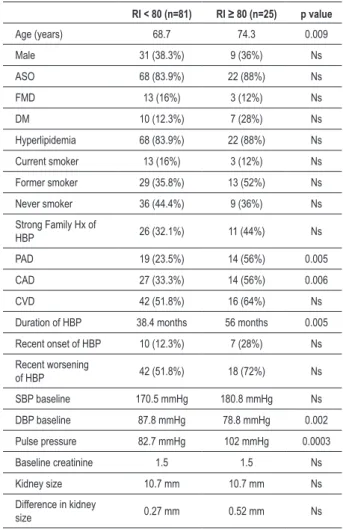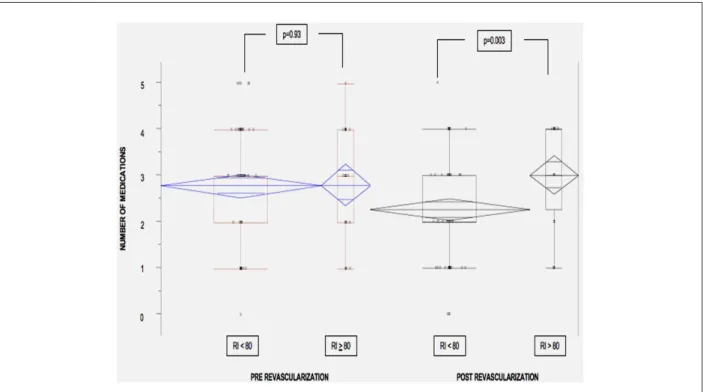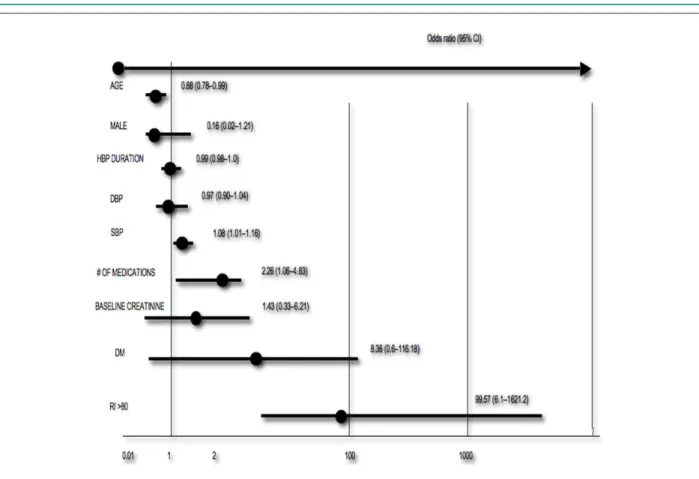Renal Resistance Index Predicting Outcome of Renal
Revascularization for Renovascular Hypertension
Simone N. Santos
1, Luiz R. Leite
1, Tak Sun Tse
2, Rebecca Beck
2, Robert A. Lee
2, Roger F. J. Shepherd
2Hospital Brasília1, Brasília, DF - Brazil; Mayo Clinic and Mayo Foundation2, Rochester Minnesota
Mailing address: Simone Nascimento dos Santos •
SMDB CJ 16 Lote 5 CASA A - Lago Sul - 71680-160 - Brasília, DF - Brazil E-mail: simonens@cardiol.br, sns2003@uol.com.br
Manuscript received March 24, 2009; revised manuscript received July 27, 2009; accepted August 10, 2009.
Abstract
Background: Renal artery stenosis (RAS) is a potentially correctable cause of hypertension and ischemic nephropathy. Despite successful renal revascularization, not all patients (pt) overcome it and some get worse.
Objective: This study was designed to assess the value of renal resistance index (RI) in predicting the outcome of renal revascularization.
Methods: Between Jan 1998 and Feb 2001, 2,933 pts were referred to renal duplex ultrasound. 106 out of these had significant RAS and underwent angiography and renal revascularization. Arterial blood pressure (BP) was measured before and after the intervention, at intervals of up to 2 years and medications recorded. Prior to revascularization, RI was measured at 3 sites of each kidney and averaged.
Results: Out of the 106 patients, 81 had RI<80 and 25 RI≥80. RAS was corrected with angioplasty (PTA) alone in 25 pts,
PTA + stent in 56 pts and corrected by surgery in 25 pts. Of patients who benefited from renal revascularization; 57 of the 81 patients with RI <80 improved as compared to 5 of 25 with RI≥80. Using a multiple logistic regression model, RI was significantly associated with BP outcome (p=0.001), adjusted for the effects of age, sex, SBP, DBP, duration of hypertension, type of revascularization, number of medication in use, creatinine level, presence of diabetes mellitus, hypercholesterolemia, stroke, peripheral and coronary artery disease and kidney size (OR 99.6 - 95%CI for OR 6.1 to 1,621.2).
Conclusion: Intrarenal arterial resistance measured by duplex ultrasound plays an important role in predicting BP outcome after renal revascularization for RAS. (Arq Bras Cardiol 2010; 94(4):426-430)
Key words: Renal artery obstruction; hypertension, renovascular; renal insufficiency; kidney/surgery.
renal artery stenosis6. It is clear that renal artery stenosis is a progressive disease and that this progression can be fast in some patients.
Unfortunately, despite successful renal revascularization, not all patients have improved control of high blood pressure and/or presented improved renal function7. Duplex ultrasound has been used to evaluate the results and follow-up of surgical as well as endovascular interventions8,9. The main goal of our investigation was to assess the value of a duplex derived renal resistance index (RI) in predicting the outcome of revascularization in patients with renovascular disease seen in a tertiary care center.
Methods
We evaluated 2933 patients who had renal artery duplex ultrasound (US) studies performed between January 1998 and February 2001. We selected for further analysis by retrospective chart review 108 patients who met the criteria of our study definition, which was: high blood pressure, renal artery stenosis of more than 60% in duplex US and underwent renal revascularization by angioplasty, stenting or surgery. Two patients did not give consent for research proposal and were excluded. Our study population comprised 106 patients.
Introduction
Renal vascular disease due to renal artery stenosis (RAS) is an important cause of hypertension (HBP) and ischemic nephropathy. It accounts for up to half of patients with secondary hypertension and is also a common and increasing cause of end-stage renal disease affecting up to 120,000 in the USA.
Atherosclerosis accounts for 70% of these patients and arterial fibrodysplasia is the second leading cause of occlusive disease found in 20% to 25% of them1,2. Although the prevalence is only 1% to 6% in the overall hypertensive patients3, it is a potentially curable cause of arterial hypertension and ischemic kidney failure.
Reports on the natural history of renal artery stenosis have shown progression of renal artery stenosis in 30% to 53% of patients monitored for up to 10 years4,5. Loss of
Patient’s clinical features and ultrasound findings were compared in two groups of patients: with resistance index smaller than 80 and with resistance index greater or equal to 80. The clinical features were: age, sex, body mass index, smoking, severity and duration of high blood pressure, measurements of blood pressure before intervention and at follow-up visits up to 2 years. We also ascertained the presence of family history of high blood pressure, diabetes, hypercholesterolemia, coronary artery disease, peripheral artery disease, carotid and mesenteric artery disease. Diabetes was considered to be present if a patient was being treated with insulin or oral agents or had a fasting blood glucose level higher than 7.0 mmol/l (126 mg/dl). Dyslipidemia was considered to be present if the concentration of total cholesterol was greater than 6.21 mmol/l (240 mg/dl), the triglyceride level was greater than 2.26 mmol/l (200 mg/dl), or the high-density lipoprotein cholesterol level was smaller than 1.03 mmol/l (40 mg/dl). Renal function was analyzed looking at creatinine blood levels before intervention and at follow-up visits up to 2 years. Number and type of medication before and following intervention were recorded. Renal doppler ultrasound was performed using SequoiaTM (Siemens Medical Solutions USA Inc., Ultrasound Division, Mountain View, CA). The aorta and renal artery Doppler ultrasound findings analyzed were: aortic diameter; peak systolic velocity in the abdominal aorta; kidney size; degree of stenosis; peak systolic velocity, end-diastolic velocity, acceleration time in the upper, middle and lower renal pole (3 sites of each kidney and averaged). With these measurements, the resistance index was calculated using the following equation: [1-(end-diastolic velocity ÷ peak systolic velocity)] x100. All Doppler ultrasound findings were considered as an average of 3 measurements. Procedural technical success rate and complications were also reviewed.
Statistical analysis
Continuous data are expressed as mean ± standard deviation. Statistical analysis was done using the SPSS package. Univariate comparisons of risk factors and other dichotomous variables between study groups were performed with chi2 test. Continuous measures were evaluated with the Wilcoxon rank test or t-test as appropriate. Stepwise logistic regression was used to determine the association of the strong covariates to the RI.
Results
The entire cohort with 106 patients had a mean age of 70 years, 66 females and 40 males. Three forth of patients had either recent onset of HBP (22.6%) or recent worsening of HBP (56.6%). Nearly half of them had bilateral renal artery disease (44.3%). The commonest etiology of RAS was atherosclerosis (ASO) in 85% of the patients and arterial fibrodysplasia (FMD) was found in 15% of them.
The treatment chosen was renal artery angioplasty in 24% of the patients, surgery in 24% and renal artery angioplasty/ stenting in 56%.
We divided 106 patients into two groups based on RI: low RI (<80) - 81 patients; high RI (≥80) - 25 patients. The results are listed in Table 1. Patients with low RI were younger than
patients with high RI (68.7y x 74,3y - p=0.009). Patients with high RI were more likely to have peripheral artery disease (23.5% x 56% - p=0.005) and coronary artery disease (33.3% x 56% - p=0.006) than patients with low RI. Patients with high RI had a longer duration of HBP than patients with low RI (38.4 mths x 56 mths - p=0.005). Patients with high RI had a higher pulse pressure than patients with low RI (82.7 mmHg x 102 mmHg - p=0.0003).
The blood pressure outcome was classified as no benefit, improvement and cure (Figure 1). In 81 patients with low RI, the majority improved (57 patients) and 2 were cured. 22 patients had no benefit. In 25 patients with high RI 20 had no benefit and only 5 improved. Furthermore, looking at actual BP results post revascularization there was a significant difference in SBP being high for patients with high RI (157 mmHg x 143 mmHg - p=0.04).
After revascularization, patients with low RI required fewer medications for BP control than patients with high RI (Figure 2).
Table 1 - Baseline characteristics: two groups based on resistance
index (total 106 patients)
RI < 80 (n=81) RI ≥ 80 (n=25) p value
Age (years) 68.7 74.3 0.009
Male 31 (38.3%) 9 (36%) Ns
ASO 68 (83.9%) 22 (88%) Ns
FMD 13 (16%) 3 (12%) Ns
DM 10 (12.3%) 7 (28%) Ns
Hyperlipidemia 68 (83.9%) 22 (88%) Ns
Current smoker 13 (16%) 3 (12%) Ns
Former smoker 29 (35.8%) 13 (52%) Ns
Never smoker 36 (44.4%) 9 (36%) Ns
Strong Family Hx of
HBP 26 (32.1%) 11 (44%) Ns
PAD 19 (23.5%) 14 (56%) 0.005
CAD 27 (33.3%) 14 (56%) 0.006
CVD 42 (51.8%) 16 (64%) Ns
Duration of HBP 38.4 months 56 months 0.005
Recent onset of HBP 10 (12.3%) 7 (28%) Ns
Recent worsening
of HBP 42 (51.8%) 18 (72%) Ns
SBP baseline 170.5 mmHg 180.8 mmHg Ns
DBP baseline 87.8 mmHg 78.8 mmHg 0.002
Pulse pressure 82.7 mmHg 102 mmHg 0.0003
Baseline creatinine 1.5 1.5 Ns
Kidney size 10.7 mm 10.7 mm Ns
Difference in kidney
size 0.27 mm 0.52 mm Ns
RI - resistance index; ASO - atherosclerosis; FMD - ibromuscular displasia;
For creatinine outcome, there were no differences between the two groups.
In multivariate analysis by logistic regression (Figure 3), using all possible predictor variables in the model, we found that RI was the most powerful predictor for no improvement in BP outcome (OR 99.6 - 95%CI 6.1-1621.2).
Discussion
Renal vascular disease due to renal artery stenosis is the most common cause of secondary hypertension. ASO accounts for 70% of these patients and FMD is the second leading cause of occlusive disease found in 20% to 25% of them2. We found a similar pattern of distribution in etiology in our patients.
Figure 1 - Blood pressure outcome after renal artery revascularization: two groups based on resistance index (total 106 patients). RI - resistance index.
Figure 2 - Number of blood pressure medications pre and post renal artery revascularization.
Figure 3 - Multivariate analysis for no improvement in blood pressure outcome after renal artery revascularization.
majority improved (57 patients) and 2 were cured. 22 patients had no benefit. In 25 patients with high RI 20 had no benefit and only 5 improved.
One possible reason for a poor outcome of renal artery revascularization may be an increased vascular resistance in the kidney parenchyma due to nephrosclerosis or glomerulosclerosis from long standing hypertension. Duplex ultrasound has been used to evaluate the results and follow-up of surgical as well as endovascular interventions5,15,16. Few
studies investigated whether a high level of resistance to flow in segmental renal arteries measured by duplex US could be used to select appropriate patients for treatment17-19. This study correlated a high RI measured by duplex US with failure to improve HBP after renal artery revascularization.
Our study showed that patients with high RI were older, had a higher probability of coexisting atherosclerosis in other beds such as peripheral arteries and coronary arteries, presented longer duration of HBP and high pulse pressure. These findings may be useful to identify a group of patients at higher risk for no improvement in BP outcome after renal artery revascularization. Although patients with high RI are at higher risk, multivariate analysis RI showed to be the most powerful independent predictor of no improvement in blood pressure outcome [OR 99.6 (95%CI 6.1-1621.2)]. Younger patients [OR 0.88 (95%CI 0.78-0.99)], higher SBP [OR 1.08 (95%CI 1.01-1.16)] and higher number of medications before intervention [OR 2.26 (95%CI
1.06-4.83)] were also independently related to poor outcome with less statistic significance.
Conclusion
To conclude, a high renal parenchymal resistance index is associated with older age, coronary artery disease, peripheral artery disease, long standing hypertension, and high pulse pressure. Renal resistance index is a more powerful predictor of BP outcome after renal artery revascularization, than any clinical feature. A high renal resistance index correlates with a worse outcome after renal artery revascularization and may be a useful marker for those less likely to benefit from renal artery intervention.
Potential Conflict of Interest
No potential conflict of interest relevant to this article was reported.
Sources of Funding
There were no external funding sources for this study.
Study Association
References
1. Novick AC, Ziegelbaum M, Vidt DG, Gifford RW Jr, Pohl MA, Goormastic M. Trends in surgical revascularization for renal artery disease. Ten years’ experience. JAMA. 1987; 257 (4): 498-501.
2. Detection, evaluation, and treatment of renovascular hypertension. Final report. Working Group on Renovascular Hypertension. Arch Intern Med. 1987; 147 (5): 820-9.
3. Seldin DW. GG. The kidney: physiology and pathophysiology. 3rd ed. Philadelphia: Lippincott Williams & Wilkins; 2000.
4. Schreiber MJ, Pohl MA, Novick AC. The natural history of atherosclerotic and fibrous renal artery disease. Urol Clin North Am. 1984; 11 (3): 383-92.
5. Tollefson DF, Ernst CB. Natural history of atherosclerotic renal artery stenosis associated with aortic disease. J Vasc Surg. 1991; 14 (3): 327-31.
6. Guzman RP, Zierler RE, Isaacson JA, Bergelin RO, Strandness DE Jr. Renal atrophy and arterial stenosis: a prospective study with duplex ultrasound. Hypertension. 1994; 23 (3): 346-50.
7. Mikhail A, Cook GJ, Reidy J, Scoble JE. Progressive renal dysfunction despite successful renal artery angioplasty in a single kidney. Lancet. 1997; 349: 926.
8. Taylor DC, Moneta GL, Strandness DE Jr. Follow-up of renal artery stenosis by duplex ultrasound. J Vasc Surg. 1989; 9 (3): 410-5.
9. Edwards JM, Zaccardi MJ, Strandness DE Jr. A preliminary study of the role of duplex scanning in defining the adequacy of treatment of patients with renal artery fibromuscular dysplasia. J Vasc Surg. 1992; 15 (4): 604-9; discussion 9-11.
10. Paty PS, Darling RC 3rd, Lee D, Chang BB, Roddy SP, Kreienberg PB, et al. Is prosthetic renal artery reconstruction a durable procedure? An analysis of 489 bypass grafts. J Vasc Surg. 2001; 34 (1): 127-32.
11. Bush RL, Najibi S, MacDonald MJ, Lin PH, Chaikof EL, Martin LG, et al. Endovascular revascularization of renal artery stenosis: technical and clinical results. J Vasc Surg. 2001; 33 (5): 1041-9.
12. Giroux MF, Soulez G, Therasse E, Nicolet V, Froment D, Courteau M, et al. Percutaneous revascularization of the renal arteries: predictors of outcome. J Vasc Interv Radiol. 2000; 11 (6): 713-20.
13. Burket MW, Cooper CJ, Kennedy DJ, Brewster PS, Ansel GM, Moore JA, et al. Renal artery angioplasty and stent placement: predictors of a favorable outcome. Am Heart J. 2000; 139 (1 Pt 1): 64-71.
14. Bonelli FS, McKusick MA, Textor SC, Kos PB, Stanson AW, Johnson CM, et al. Renal artery angioplasty: technical results and clinical outcome in 320 patients. Mayo Clin Proc. 1995; 70 (11): 1041-52.
15. Jensen G. Renovascular hypertension: new diagnostic and therapeutic procedures. Scand J Urol Nephrol Suppl. 1995; 170: 1-78.
16. Soulez G, Therasse E, Qanadli SD, Froment D, Léveillé M, Nicolet V, et al. Prediction of clinical response after renal angioplasty: respective value of renal Doppler sonography and scintigraphy. AJR Am J Roentgenol. 2003; 181(4):1029-35.
17. Radermacher J, Weinkove R, Haller H. Techniques for predicting a favourable response to renal angioplasty in patients with renovascular disease. Curr Opin Nephrol Hypertens. 2001; 10 (6): 799-805.
18. Radermacher J, Ellis S, Haller H. Renal resistance index and progression of renal disease. Hypertension. 2002; 39 (2 Pt 2): 699-703.


